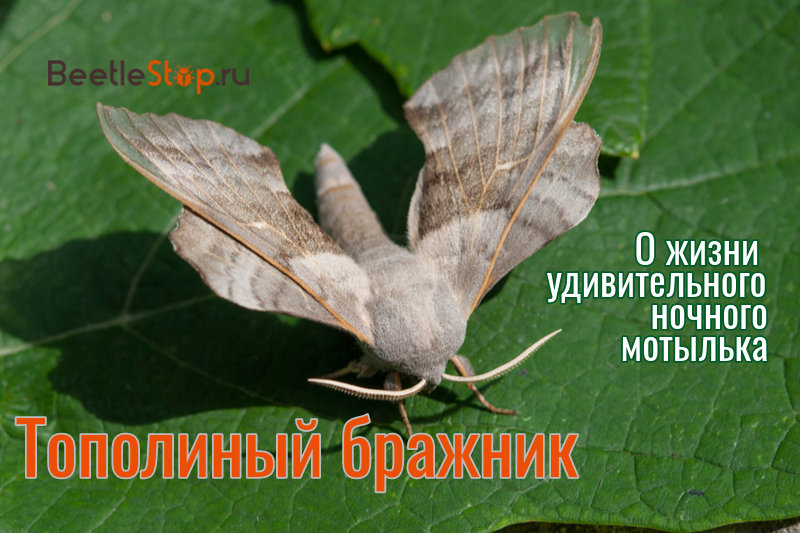Hogweed poplar - a night butterfly that does not eat
Brazhniki - large and medium butterflies flying at dusk and at night. For their ability to drink nectar, hovering over flowers, they are called northern hummingbirds. These are the best flyers in the Lepidoptera squad. Butterflies are able to reach speeds of up to 50 km / h, overcome huge distances during migration. The family has more than 1 thousand species, one of the butterflies living in Russia is the poplar hawthorn. The imago lives in parks and gardens, does not eat. A large green caterpillar feeds on poplar, aspen, willow, alder. At the end of the abdomen of the larva there is a horn, a hallmark of the family of hawks.

View description
Poplar bog (Laothoepopuli) belongs to the family of bog moths, the genus Laothoe. A large view of night butterflies with a wingspan of 70-100 mm. Coloring of insects of dark muted shades. There are individuals of gray-brown, yellowish, gray-brown color. The wings are narrow; in the front, the length is twice the width. The outer edge is wavy. The hind wings are shorter and wider, at the apex of the outer edge there is a noticeable notch. The base of the front wings is brighter. They are covered with a blurry pattern of dark bandages.
Interesting fact. During the rest, the moth folds its wings in a peculiar way - the pair of hind ones is half hidden by the pair of front ones. Visually, they resemble a dry leaf of poplar.
Long red hairs at the base of the hind wings form distinct spots. The body is conical in shape, pointed at the end. Painted to the color of the wings. Head, chest and abdomen in gray-yellow pubescence. The eyes are large, facet type. Antenna located between the crown of the head and forehead are sensory organs. With their help, butterflies catch smells and vibrations of air. Females are distinguished by a lighter color, a large body and a filiform tendrils (males have comb antennas).
Larva
The large caterpillar of the poplar parasitic is light and dark green in color. Bluish-white colors are less common. The length of her body is 65-85 mm. On the sides there are 7 oblique yellowish stripes. The whole body is covered with yellow dots, many individuals have 1-2 rows of reddish spots. Bright dots are characteristic of insects that feed on willow. The larva moves with the help of 5 pairs of legs. On the eighth segment of the abdomen dense outgrowth. Straight horn yellow-green.
Distribution area
Poplar hawthorn is the most common species in the Palearctic and the Middle East. Insects are found in Europe, Syria, Iran, China, in the south of the Mediterranean. In Russia, butterflies are common in many areas, live in the west of Siberia, in Buryatia. Moths settle in forests, parks, groves and gardens, on the banks of rivers.
Lifestyle
Moths are active at dusk. In the daytime, they sit motionless on tree trunks. Dark coloring helps mask, merging with the color of the bark. Adults fly from May to September. In a cool climate, one generation develops per year, closer to the south - two generations. The first is April – June, the second is July – August. During rest, imagos hold on to the tree only with their forelimbs.
In case of danger, they raise their front wings, showing a red-orange spot that the enemy can perceive as eyes. A similar defense mechanism is present in the behavior of the ophthalmic hawthorn.Unlike many species of the Laothoepopuli adult family, they are devoid of proboscis and do not feed. For caterpillars, the main fodder plants are poplar, willow, aspen, birch, ash and apple tree.
Breeding
Moths are insects with a full cycle of transformation. In late spring, mating occurs. Fertilized females lay up to 200 large, pale green eggs on the leaves of fodder plants. After 7-10 days, caterpillars appear. With age, their color changes slightly.
In late June, caterpillars descend from trees for pupation in the soil at a depth of 2-3 cm. The pupa is black. In a warm climate, a young butterfly emerges from it by July. She needs to crawl to the dais to spread her wings. Holding the twig with its feet, the moth hangs down, the hemolymph flows along the veins of the wings and gives them the desired shape. Autumn pupae remain overwintering, adults are born next spring.
Information. Part of the pupae is eaten by natural enemies - moles and shrews.
Butterfly protection
Cutting down poplars and replacing them with other trees has led to a decrease in the population of Laothoepopuli in some regions of Russia. In the territory of the Belgorod region, the butterfly is classified as a species that is declining in number. It is listed in the regional Red Book. It is forbidden to catch butterflies and violate their habitats.


 (votes: 10, average rating: 4,60 out of 5)
(votes: 10, average rating: 4,60 out of 5)
Why do you see something living, immediately kill ??? Without need, without knowing who it is, do you think in nature there is someone unnecessary and not useful? And then crying for losses ...